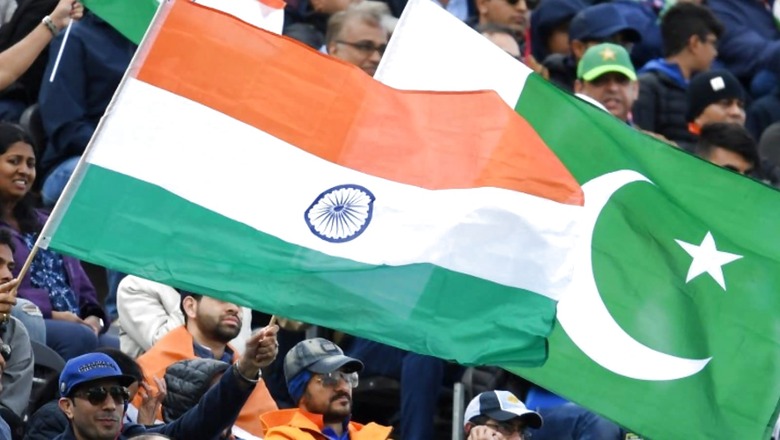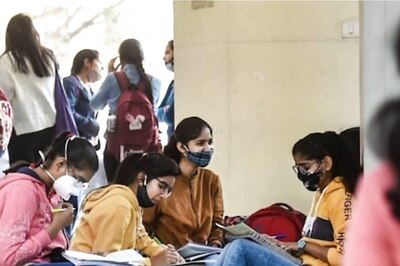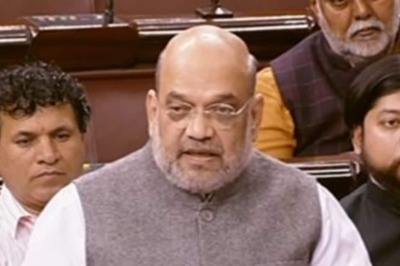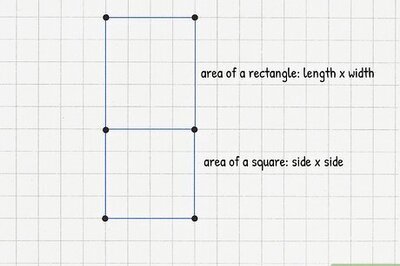
views
Seventy-five years is a milestone, in fact, it is a landmark, more specifically a diamond jubilee, or better yet, a lifetime indeed. A lifetime encompasses an eclectic mix of memories and not all of them will be pleasant.
August 2022 marked the 75th year of independence for the world’s largest secular democracy of India and the creation of the Islamic Republic of Pakistan.
The countries share a common history of colonial rule, similar cultures (especially between the Punjabi and Sindhi communities in the north and a large Muslim population), a mutual affinity for cricket, cinema, and a similar culinary palate in the north.
But they also share a turbulent history of violent partition, three brutal wars, multiple border skirmishes, geopolitical standoffs, nuclear arms squared off, trade embargos, visa restrictions, kerfuffles at the United Nations and the International Court of Justice (ICJ).
The post-partition generation has almost passed on, and those who remember it today were too young to have influenced it. The diaspora in both the countries today have been born into a geopolitical imbroglio, many haven’t been acquainted with history enough to either know the origins or seek the answers to the origins of the animosity, but they know it lingers and festers and the subcontinent is one accidental missile and one stray fighter jet away from military escalation.
Several peace initiatives like ‘Aman Ki Asha’, track two diplomacy, backchannel talks, mediation, cricket for peace, goodwill tours, and summits have come and gone, and their ephemerality has also meant their inability to change the larger discourse.
It’s been a juxtaposition, where cultural ties between its diaspora have been kindred, but geopolitical thorns and diplomatic diatribe have precluded the prospect for peace and made the concept of peace, practically utopian.
PERNICIOUSNESS OF PARTITION
A lot of history is indeed esoteric. In some ways, it’s akin to solving a mystery in a fiction novel, only those who seek it (information), shall find what they’re looking for. To understand the roots of the discontent, perhaps, one needs to follow the Julie Andrews school of thought and that would be to “start at the very beginning, a very good place to start”.
Salman Rushdie, the British-India author had a near-brush with death recently. He sadly knows the pain of a dagger stab. One of Rushdie’s seminal novels is Midnight’s Children, which is a loose allegory for events in 1947 British Raj India and after the Partition of India. That Rushdie dagger stab was familiar to many during those fateful days, leading up to the independence of two separate nations.
The Partition of India is an event that changed both history and geography. It was the largest mass migration in human history, with records estimating that 15 million people set across on foot, trains, and bullock carts, and two million of those, would never see a new homeland but meet their fate en route.
It remains one of history’s many cruel injustices and cruel irony would rear its ugly head, that a British barrister in Sir Cyril Radcliffe, one who had never been East of Paris before his visit to India, would be tasked with understanding a land he was not acquainted with and yet decide its fate and the fate of millions forever.
As the British barrister drew a line on a map, this cut bloodlines, as Hindus, Muslims, and Sikhs, who had lived for generations together in communal harmony, suddenly turned to communalism as neighbours turned on neighbours; children eschewed childhood innocence and revoked friendships, the zest for life in one of the richest provinces of India, Punjab, became a quest for life, rather as the song goes, just ‘stayin alive’.
We are at the last generation that remembers partition, in fact, we are three decades too late, because the ones who do, were too young to have influenced it and too young to understand the perils of fissiparousness. It’s a cardinal sin that while other atrocities such as the Holocaust and Apartheid have been better documented for posterity, we only now have a partition museum, to chronicle the negligence of the Raj, to remember profound stories, document the largest mass migration in human history and understand how history shaped geography and how geography will continue to shape geopolitics. But above all, just simply remember stories, people, and the familiar places that they once called home, that overnight became dangerous, and new destinations they were never acquainted with, would now become their safest shelters.
THE ORIGINS OF THE PAKISTAN STATE
It’s from here that the seeds of discontent were sown, as Pakistan was born out of a bloody partition, under the backdrop of displacement, religious tension, ethnic killings, and distrust for the larger neighbor. Wounds heal, but the scars of partition linger.
The first problem stems from the fact that India and Pakistan don’t agree on history. In the psyche of the Pakistani state, there is an overt desire to retell the story of partition as a necessity and contrive it as a boon for the subcontinent.
It’s tautological to add that of course, without partition, Pakistan wouldn’t exist. But here is the larger conundrum. The Pakistani state has been unable to deracinate the process and brutality of a botched partition done myopically versus the 21st-century territorial sovereignty of the modern-day state of Pakistan. Condemning the brutalities of partition doesn’t necessarily impede or dilute a country’s sovereignty. Both states can accept and recognize their 1947 territorial boundaries and yet show contrition to the egregiousness of partition.
But herein lies the larger enigma. When two parties don’t agree on history (partition and its reasons), they won’t agree on the present state that they find themselves in and ergo there doesn’t exist an environment to find a constructive solution. Even more troubling, is the first part of solving a problem lies in acknowledging that there is a problem, to begin with.
Pakistan continues to be one of the only two modern-day nation-states carved in the name of a religion, and it prides itself on being the only nation to have been carved out in the name of Islam. It is also a nuclear weapon state, and home to (as the sobriquet goes) the ‘Islamic Bomb’; implying it’s the only Muslim nation to have nuclear weapons. It’s often said that while most states have an army, in Pakistan, it is the army that has a state.
Pakistan stands for “land of the pure”, but its institutions, least of all, its political ones have been far from that, more often projected as corrosive and corrupt by the military establishment, which is seen as the only purveyor of stability and integrity. For long, the military in Pakistan has protected both the country’s ideological frontiers, along with its real borders.
As Pakistan’s former ambassador to Washington, Husain Haqqani so accurately and articulately quotes in his book, “after Partition, Pakistan got 19 per cent of British India’s population, 17 per cent of its economic resources, but 33 per cent of its army. His thesis was accurate in saying, that most states raise an army to counter the threat, but in Pakistan’s case, they raised the threat of a much larger and perceived hostile neighbour India, to justify the size of the army.
Some would say that the Islamic State of Pakistan’s survival has been a miracle. A miracle that was both troubled by its history and exacerbated by its geography. Pakistanis would quip that the distance, economic disparities, and cultural differences between West and East Pakistan, were united only by Pakistan International Airlines, as it flew over vast swathes of Indian territory.
Jinnah initially touted Pakistan as a secular state with Islam in the center and in his earliest remarks made a clarion call saying: “You are free to go to your temples, you are free to go to your mosques or to any other place or worship in this State of Pakistan”.
And yet ironically, Jinnah, eschewed some of that bonhomie by imposing Urdu on the
Bengalis of the East, which sowed the seeds of disenchantment with their more Punjabi-dominated Western front. They found the Urdu imposition a brazen violation of their linguistic pride, and a domino effect unfolded in their lack of representation in Parliament and the disregard for the 1970 electoral results won by the Awami League, as enough to call for an independence movement.
Whether Jinnah wanted an Islamic state or not, however, is now irrelevant. Islam is the state religion and is codified by the Constitution, explicitly precluding non-Muslims from the highest offices in the land (President and Prime Minister).
The poem, ‘Pakistan Ka Matlab Kya’, which translates to, what is the meaning of Pakistan, was written by a former schoolteacher from Sialkot named Asghar Sodai. It begs a big question.
In the run-up to partition, some clerics felt that early exposure to Western education and British patronage had put India’s Hindu majority well ahead of their Muslim brethren and this unfair advantage would exacerbate in terms of jobs, especially in government jobs, once the British were to leave.
Muslim Bengali elites in Dhaka and Bengal played a seminal role and tipped the British decision to partition Bengal and subsequently began the process of creating a separate homeland for the Muslims. And yet the same Bengalis opted out of Pakistan. 1971 was epochal as it changed the contours of South Asia, the second time in under three decades, where South Asia underwent a rapid geographic metamorphosis.
Bangladesh, although born out of a bloody war, and one that was erstwhile East Pakistan has carved its own success story in a shorter time than its former Western front.
Scholars such as Pervez Hoodbhoy and C Raja Mohan write on Bangladesh’s success story and how it overtook its western predecessor. Bangladesh, unlike Pakistan, didn’t exist as a carceral security state, one that got into a security paradox, driven by one-upmanship, that later prioritized nuclearization in the aftermath of the 1971 war, further exacerbated by Indira Gandhi’s Operation Smiling Buddha in 1974. Zulfiqar Ali Bhutto, the civilian leader once declared that it would be a 1,000-year war with India, and then his successor, military dictator Zia-ul-Haq brazenly stated that Pakistan would bleed India with a 1,000 cuts.
Instead, Dhaka focused on the upliftment of its marginalized sections of society, prioritized human development, and yes, it’s far from a utopia as a crowded South Asian country and has problems endemic to the region. However, Bangladesh has been successful in carving out institutions such as the Grameen Bank and home to BRAC, organizations focused on the upliftment and welfare of the most marginalised sections of society.
And Bangladesh has continued to remain as Islamic a nation as its East Pakistan avatar. Scholars note that mosques in Bangladesh have more “namazis” than Pakistan, as well as madrassas. But Bangladesh, unlike the political dispensation in Pakistan, didn’t focus on a rivalry with India, even though, there remain several thorny issues from the Teesta River dispute and Rohingya migration crisis.
The historian, writer, and author Ram Guha once called India the most interesting country in the world since he said India abjured the European context of nationhood. The European context of nationhood, according to Guha, was formed on the basis of one religion, one language, and one enemy. India, he said, doesn’t follow this principle, but Pakistan does, in the form of Islam, Urdu, and India as the enemy.
Hindsight is wonderful, but it was always going to be a herculean task to forge a nation on the basis of a single religious identity from multiple ethnic groups, each with its own unique language, culture, and habits. The acid test here is understanding that when the Turks stop being Muslim, they’re still Turks, when the Iranians stop being Muslim, they’re very much Persians and the Emiratis are still Arabs when they’re not Muslims, but what would that make most Sunni Muslim Pakistanis if Islam were taken away? India lite? Surely, the need and identity to discern themselves made Pakistan a hardened Islamic state.
The 1971 war and subsequent creation of Bangladesh and a secular India, which for the longest time had more Muslims than the state created for British India’s Muslims is perhaps proof that the two-nation theory died a long time ago. Yet, of course, there is some evidence to insinuate that India’s secular credentials remain tarnished, and perhaps, there is an element of truth and yet schadenfreude in Pakistan, that this was the reason for a separate homeland.
DIPLOMATIC STALEMATE
India-Pakistan diplomacy continues to remain a classic case of two steps forward and three steps back.
This isn’t just a nebulous argument, to elucidate this point, since 1999 alone, the late Prime Minister Atal Bihari Vajpayee in his overtures of peace, took the bus to Lahore, signed the Lahore Declaration at the Minar-e-Pakistan, the very symbol of Pakistan’s founding, thereby assuaging hardliners in Pakistan that India had indeed accepted the state after partition. As the ink barely dried on the Lahore Declaration, the then Army Chief Pervez Musharraf was plotting the Kargil war, a dangerous skirmish between the now two-nuclear armed states.
Despite the incursions of Kargil heights, a military conflict, and a democratically elected government deposed by the same perpetrator, Prime Minister Vajpayee tried to reset ties with Pakistan by inviting General Musharraf, now President to India for the historic Agra Summit.
Yet, shortly after that, the tense border standoff in 2001–2002 dubbed Operation Parakram was in response to a terrorist attack on the Indian Parliament in December 2001 by Lashkar-e-Taiba and Jaish-e-Mohammad groups, both of
which have received patronage from certain sections of the Pakistan state.
The most propitious period in India-Pakistan relations was to follow from 2004-2007, which then imploded with the Mumbai Terror Attacks of 2008. Since then, ties have hit a nadir and despite, premonitions in Pakistan of what a Narendra Modi government meant, in 2014, Modi did invite Nawaz Sharif, his counterpart to the swearing-in ceremony. In 2015, an impromptu drop-off in Lahore, by Prime Minister Modi while returning from Kabul, displayed political bonhomie over political brouhaha.
Shortly thereafter, the attacks on the Pathankot airbase, the Uri attacks, followed by a surgical strike on Pakistan’s side of Kashmir, the Balakot airstrikes, the subsequent dogfight, Pakistan capturing an Indian Prisoner of War, in Abhinandan Varthaman, and India’s revocation of Article 370 have seen ties at its lowest ebb in a non-wartime scenario.
The best way to describe India-Pakistan ties would be apropos of former U.S. Ambassador to Russia, Michael McFaul’s book, which is titled ‘From Cold War to Hot Peace’. A Cold War is far too cliched and done, but the incidents above evince, that India-Pakistan ties exist in a constant “no-war but no peace” scenario. The “hot peace” is epitomized as peace on tenterhooks, after incidents of diplomatic awry. The most propitious periods of the Lahore Declaration, the Agra Summit, the 2004-07 period, and new civilian leadership in 2014, invariably were all derailed and redundant.
There is a coterie in Pakistan that sees India as too hardline for peace, assuming that a post-BJP dispensation will see auspicious times again. That’s naïve and historically inaccurate, forgetting that three out of the four wars, were fought when there was a Congress government was at the helm.
Assuming a change of civilian leadership would bear new fruit would be as naïve to assume a new paint job is a panacea to a house built on an earthquake faultline.
There have been many permutation-combinations of Indo-Pak leadership and each one with its own augurs of peace. As Ambassador Haqqani notes, when it was Rajiv Gandhi and Benazir Bhutto, the belief was these two were young, not traumatized by the horrors of partition, and would solve what their parents couldn’t. When it was Vajpayee and Nawaz, the soothsayers stated, that two-right of center politicians is what political will was needed. When their successors in President Musharraf and Prime Minister Singh met, the belief was, they were outside the political establishment and born in each other’s countries, pre-partition, and hence they would have the missing resolve. And finally, assuming that Prime Minister Modi and Prime Minister Imran Khan, two charismatic populists with mass
appeal could bring about peace. The premonitions and products are as wide as the Pacific Ocean.
Many see Pakistan’s geopolitical and military raison d’etre being Kashmir – which many in Pakistan see as the unfinished chapter of partition and one that it was wronged to not have been given during the Radcliffe demarcation. Neither side accepts the other’s version of Kashmir, with each claiming either full integrity of the state or alleging dispute.
Islamabad’s frustration with New Delhi has been India’s repeated stance that Kashmir is a bilateral issue with Pakistan and to Pakistan, New Delhi echoes that Kashmir is an internal matter with no purview for Pakistan.
Ties between the nuclear-armed rivals have hit worrisome lows on many an occasion, but since India’s revocation of Article 370, it was the first time that Islamabad threw the gauntlet and reacted to something New Delhi did, whereas historical evidence cites that it has been New Delhi’s umbrage with Islamabad on cross-border terrorism and using proxies as tools of statecraft to wrest away control of Kashmir.
Ironically, for me, the real panacea comes in what Pakistan’s former Foreign Minister Khurshid Kasuri said in his book, ‘Neither A Hawk Nor Dove’, when he said “our part of Kashmir, we have and you can’t get it and your part of Kashmir, you have and we can’t get it”.
This is realistic and accurate. For all the claims and historical injustice, neither side can wrest control without military conflict and credibly, the Italian concept of “irredentism”, whereby a country can restore any territory formerly belonging to it, is a myth in calculated geopolitics of hubris and polarization. Neither side will hand over an inch, even Musharraf’s lofty four-point formula on Kashmir, said there would be no change in borders.
On my podcast, The Global Detail, noted journalist, Wajahat Khan at Nikkei told me on comparison between the two at 75 years, “India has done a remarkable job, despite its hiccups under the current political dispensation. India has become the world’s fifth largest economy, India surpassed the U.K. to become a 3-trillion-dollar economy, it took 75 years to beat its colonial master, it has become the fifth largest economy – ironic, beautiful, and sublime if you’re Indian.”
He goes on to add “whereas, for Pakistan, experiments with martial law, proxy war, civil war, self-flagellation, self-destruction hasn’t paid off. Pakistanis are some of the smartest and yet most underutilized in the world. The economy is in tatters and while they’re commemorating their 75th year of independence, they’re negotiating the 23rd bailout with the IMF, one of the most bailed-out countries in the world. Not much of a statistic for a country that was supposed to be the pride of Asia that was given advice to South Korea and Emiratis in the 1960s.”
The noted South Asia scholar writer, Stephen Cohen, argued that the rivalry between India and Pakistan has proven to be one of the world’s most intractable international conflicts since 1947 and will continue for 100 years.
Sadly, at 75 years already gone, it’s hard to prove otherwise.
Read all the Latest Opinion News and Breaking News here




















Comments
0 comment